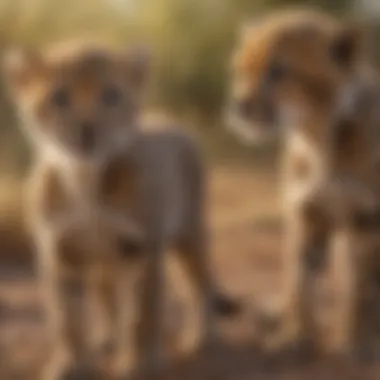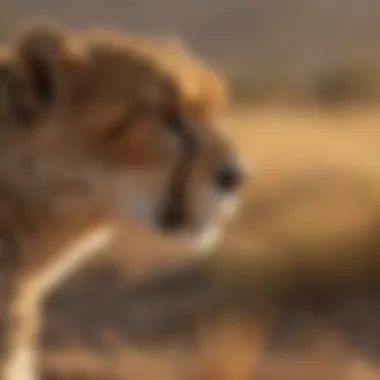Understanding Cheetah Habitats Across Africa


Intro
Cheetahs are among the most iconic and admired mammals on the African continent, known for their incredible speed and unique adaptations. To properly apprecaite these magnificent creatures, it's crucial to understand their habitats, the environments they thrive in, and the various challenges they encounter in the wild. This exploration will take us across diverse landscapes, from the rolling savannas to the striking grasslands, emphasizing the importance of conservation efforts in safeguarding their homes.
In this article, we'll deep dive into multiple facets of cheetah habitats, examining their geographic distribution, preferred environments, food sources, and touches on the social structures of these felines. We'll also discuss the impact of human activities and the ongoing initiatives aimed at preserving these remarkable animals.
Animal Overview
Common Names
Cheetahs are commonly referred to as "hunting leopards" in some Afrikaans-speaking regions. Other names used in cultural contexts have included the term "fast cat." Beyond their known scientific name Acinonyx jubatus, these aliases reflect their importance in local folklore and ecology.
Scientific Classification
- Kingdom: Animalia
- Phylum: Chordata
- Class: Mammalia
- Order: Carnivora
- Family: Felidae
- Genus: Acinonyx
- Species: A. jubatus
Geographic Range
Cheetahs primarily inhabit regions in Africa, with their populations scattered across various countries. Significant populations can be found in:
- Southern Africa (Namibia, Botswana, South Africa)
- Eastern Africa (Kenya, Tanzania)
- Portions of North Africa (North Africa in limited regions)
They typically prefer open landscapes, which allow them to utilize their speed while hunting. However, their distribution is not uniform. Their habitat stretch ranges from woodland areas to arid zones, illustrating their adaptability.
Behavior and Social Structure
Social Behavior
Cheetahs display fascinating social structures; while they are primarily solitary animals, they can be found in groups called coalitions. Male cheetahs often band together, forming bonds for protection and social interaction, while females mostly remain independent, except when raising cubs.
Communication
Cheetahs possess a unique set of sounds to communicate with each other, ranging from chirps and growls to short purrs. These vocalizations play a crucial role in mate selection and territory establishment. Body language, like tail movements and facial expressions, also helps convey information in their interactions.
Mating and Reproduction
The mating rituals of cheetahs are intricate. Female cheetahs often choose their mates based on size and strength, highlighting the natural selection process. After a gestation period of around 90-95 days, the female gives birth to a litter of three to five cubs, which she raises mostly on her own.
Habitat and Ecosystem
Natural Habitat
Cheetahs thrive in diverse natural environments. Whether it's the grasslands of the Serengeti or the vast savannas of Namibia, these habitats are essential for their survival. Open spaces allow them to hunt effectively, relying on speed and agility.
Food Sources and Diet
The diet of a cheetah is predominantly composed of small to medium-sized ungulates. They primarily hunt:
- Thompson's Gazelle
- Springbok
- Impala
The need for speed is evident in their hunting techniques; they are not built for endurance and usually hunt during the cooler hours of the day.
Role in Ecosystem
Cheetahs play a pivotal role in maintaining the balance of their ecosystems by controlling herbivore populations. In that way, they assist in the preservation of plant diversity, ensuring the health of the habitats they inhabit. Without such predators, there could be significant overgrazing, harming plant life and causing broader ecological issues.


"Cheetahs are not just a part of the food chain; they are integral to the health of their ecosystems, shaping the very environment they inhabit."
Understanding Cheetah Ecology
Cheetahs, those sleek and graceful felines of the African savanna, boast an ecology that intertwines with their habitat in ways both profound and intricate. Understanding Cheetah ecology is essential for several reasons. First off, it highlights their role as apex predators, which is vital for maintaining the balance in their ecosystems. A clear grasp of their ecological profile aids conservationists in crafting effective strategies tailored to protecting these creatures, ensuring their populations can thrive in a rapidly changing environment.
In the article, we will cover specific elements such as habitat preferences, hunting behavior, and social structure that all play into how these animals interact with their surroundings. Recognizing the interdependent relationships they have with flora and fauna helps us appreciate their complexities. Besides that, considering ecological benefits, such as biodiversity preservation, can result in a broader understanding of the natural world.
"Understanding the ecology of a species lights the path towards its conservation.”
By exploring the interactions between Cheetahs and their environment, we not only paint a picture of what makes these animals unique, but also emphasize the urgent need for preserving their habitats in Africa.
The Biological Profile of Cheetahs
Cheetahs are not just fast; they are biologically adept at surviving the rigors of life in the African wilderness. Their anatomy tells a story of evolution that prioritizes speed and agility. Equipped with slender bodies, long legs, and an aerodynamic design, they are built for action. Their unique black tear markings under their eyes serve a dual purpose—reducing glare from the sun and aiding in focusing on their prey.
Physiologically, cheetahs possess a heart and lungs that are larger than those of other big cats. This adaptation supports their powerful sprinting capabilities, allowing them to reach speeds of up to 70 mph in short bursts. However, this speed comes at a price, as cheetahs can only maintain it for brief periods, often just 20-30 seconds.
Their diet primarily consists of small to medium-sized ungulates such as gazelles and impalas. This dietary preference shapes their hunting strategies, which include a combination of stealth and explosive speed when closing in on their target.
Behavioral Traits Impacting Habitat Choice
Cheetah behavior intricately influences their habitat selection, which is closely connected to their survival. These cats are solitary hunters, and they prefer open terrains like savannas and grasslands where visibility and space enable them to spot and chase prey effectively. The need for large territories also plays a pivotal role in their habitat choices. A female cheetah typically requires a range of around 20 square miles, while males need even larger areas to maintain their dominance and attract mates.
Their day-to-day activities are fascinating in their own right. Cheetahs are diurnal, preferring to hunt during the cooler parts of the day, often early dawn or late afternoon. This behavior minimizes competition with larger predators like lions and hyenas, allowing them to capitalize on their unique hunting strategy. Additionally, they often seek out areas with some degree of cover, such as bushes or trees, to hide from larger predators while they stalk their prey.
In summary, cheetah behavior and their biological profile dictate the habitats they choose. This understanding is pivotal for conservation efforts aimed at preserving both cheetah populations and the ecosystems they inhabit.
By diving deep into these aspects, we will be better equipped to confront the ecological challenges presented to cheetahs in Africa today.
Geographic Distribution of Cheetahs
Understanding the geographic distribution of cheetahs is crucial for several reasons. It provides insight into their habitats, prey availability, and how human activities impact their survival. Identifying where these cats flourish helps in shaping conservation strategies and fostering a better understanding of how various environments support their unique needs. The ebb and flow of their population in diverse regions offer clues about broader ecological trends, presenting both challenges and opportunities for preservation efforts.
Regions Where Cheetahs Are Found
East Africa
East Africa, particularly countries like Kenya and Tanzania, is known for its expansive savannas and national parks, which form the backbone of cheetah habitats. The Serengeti National Park is a prime example, offering a rich tapestry of grasslands that serve as ideal hunting grounds. The abundance of prey animals such as gazelles and wildebeests contributes heavily to the area’s significance.
A notable characteristic of this region is its seasonal migrations. During the rains, new grass sprouts attract prey, and for cheetahs, this means an ample food supply. However, the popularity of this region can come with drawbacks, like increased human-wildlife conflict as tourism expands, which places more stress on the already fragile ecosystem.
Southern Africa
Meanwhile, Southern Africa showcases a different landscape. Countries like Botswana and Namibia are home to arid regions interspersed with lush valleys. The Kalahari Desert may appear inhospitable at first glance, yet it positively influences the adaptability of cheetahs. The areas surrounding the Makgadikgadi Pan provide unique hunting opportunities that blend open plains with pockets of vegetation.
The attractivity of these regions lies in their low human population density, which allows cheetahs to roam more freely. Yet, the scarcity of water during drought seasons can pose significant challenges, making it a double-edged sword in terms of habitat sustenance.
Northern Africa
In Northern Africa, the landscape shifts dramatically, introducing the desert biome. Though not the most typical habitat for cheetahs, regions like Morocco have populations that exhibit stunning adaptability. Most notable is the Sahara's edge, where pockets of grassland exist amidst arid stretches. These areas have an intriguing allure for cheetahs due to fewer competitors.
However, the characteristic of this region is arguably a double-edged sword. The incredibly harsh climatic conditions can challenge species survival, and this adaptation, while impressive, does come with serious limitations. The fluctuating environments highlight the need for conservation measures tailored to the specific habitats that cheetahs inhabit.


Cheetah Population Density Across Africa
Cheetah population density across Africa is a telling metric, speaking volumes about their health and the suitability of various habitats. Certain regions, like parts of East Africa, exhibit higher densities due to favorable prey availability, while others show a decline, often testing their survival in fragmented habitats. Understanding these patterns provides essential insights into making informed decisions regarding conservation strategies designed to protect these majestic predators.
"Understanding where cheetahs thrive is fundamental to ensuring their long-term survival, as these patterns inform how we can effectively safeguard their habitats."
As we explore different regions and the density patterns, it becomes clear that each area presents unique advantages and risks, further underscoring the need for targeted conservation efforts.
Preferred Habitats of Cheetahs
Cheetahs, the fastest land animals, require specific habitats that cater to their unique hunting strategies and social behaviors. Understanding these preferred habitats is vital in the quest for their conservation. The environments where cheetahs thrive not only support their survival but also influence their interactions within the ecosystem. To grasp the full picture, it’s essential to explore the nuances of each habitat type, how they contribute to cheetah well-being, and the challenges posed by a rapidly changing world.
Savannas: The Ideal Hunting Grounds
The savanna is, without a doubt, the hallmark habitat for cheetahs. Characterized by open grasslands interspersed with acacia trees, these areas offer a perfect blend of visibility and cover. Cheetahs rely on their speed rather than strength; thus, they prefer environments where they can make quick and strategic bursts to catch prey like gazelles. The tall grass can serve both as hiding places and vantage points during the hunt.
"In the savanna, the art of stealth meets the thrill of speed. Cheetahs must balance these two skills for a successful hunt."
Moreover, savannas are rich in biodiversity, providing not only ample prey but also a variety of plants that contribute to the ecosystem’s health. Water sources are typically nearby, supporting both flora and fauna. However, it's not all clear skies; changes in rainfall patterns due to climate change are beginning to alter these vital landscapes.
Grasslands: A Dynamic Environment
While grasslands might not seem as glamorous as the lush savanna, they play a crucial role in cheetah habitats. These grasslands can host a more dynamic ecosystem, which benefits cheetahs in surprising ways. Consisting of shorter grasses and fewer trees, visibility is often improved, allowing cheetahs to spot distant predators and prey alike.
The flexibility of grasslands makes them resilient to various environmental stresses. Consequently, cheetahs can utilize this adaptability to their advantage. They often thrive during migratory seasons when prey species like wildebeest or zebra move through these open environments. Moreover, grasslands can sometimes be considered transitional spaces, where cheetahs may find themselves navigating the edge of different ecosystems, further enhancing their hunting territory.
The Role of Wooded Areas and Hills
Though cheetahs are primarily associated with open spaces, wooded areas and hilly terrains hold their unique value in the cheetah's habitat repertoire. The vegetation in these regions can provide shelter and shade, especially in hotter climates. Such environments can be a haven during particularly harsh weather conditions or during times when hunting is less productive.
Certain wooded areas also play host to ambush hunting tactics rather than the high-speed chases typical in open habitats. In these scenarios, cheetahs utilize the added cover to stalk their prey more effectively. Hills can provide strategic advantages, allowing cheetahs to survey their surroundings and plan their approach, making them more adaptable hunters.
In summary, each habitat type serves as an essential piece in the cheetah's life puzzle. Recognizing the fragility of these environments and their integral role in the cheetah's ecology not only enhances our understanding of these majestic creatures but also emphasizes the urgent need for effective conservation strategies.
Assessing all aspects of cheetah habitats allows us to appreciate how every grass blade, tree, and hillock contributes to their survival and the broader ecosystem they inhabit.
Human Impact on Cheetah Habitats
When it comes to preserving the habitats of cheetahs, understanding the influence of human activities is essential. As the landscape of Africa evolves—driven by urbanization, agriculture, and changing land-use patterns—the delicate balance of ecosystems that sustain these magnificent animals is increasingly at risk. Examining the impact of human encroachment not only reveals the challenges faced by cheetahs but also underscores the urgency for effective conservation measures.
Urban Development and Habitat Fragmentation
Urban sprawl is one of the primary threats to cheetah habitats. As cities expand—like the sprawling urbanization seen in areas such as Nairobi or Johannesburg—natural landscapes are replaced with concrete jungles. This development leads to habitat fragmentation, making it difficult for cheetahs to roam freely in search of prey and breeding mates. The roads that often come with urban development pose significant risks, as cheetahs can find themselves in dangerous situations crossing busy roads.
For example, regions that used to be open savanna have given way to residential areas. A direct consequence of this is a reduction in the available hunting grounds. Cheetahs prefer open spaces for their high-speed chases, but as these areas diminish, they are forced into smaller pockets of land, resulting in overpopulation and competition for dwindling resources.
"The fragmentation of habitats can lead to isolated populations that struggle to thrive, severely hurting genetic diversity."
Agricultural Expansion: A Threat to Survival
As the global population continues to swell, the demand for agricultural land has surged, resulting in the conversion of natural habitats into farmlands. In regions like East Africa, vast tracts of land are being overtaken by crops such as maize or wheat, which significantly disrupts the ecosystems where cheetahs once roamed.
This agricultural encroachment not only reduces the availability of prey but also introduces human interference in the form of pesticides and other chemicals. These substances can poison not just the prey species but also the cheetahs who depend on them, leading to health issues and lowered populations. The encroachment often leads to conflict, as farmers protect their livestock against cheetah intrusions, leading to retaliatory killings.


Conservation Areas and Their Importance
In the face of these threats, conservation areas play a pivotal role in safeguarding cheetah habitats. National parks and reserves such as the Serengeti National Park in Tanzania or Kruger National Park in South Africa provide secure environments where cheetahs can hunt and thrive without the pressure of human encroachment.
However, the establishment of these protected areas is not without its challenges. There needs to be ongoing management and funding to ensure they remain effective. Collaborative efforts between governments, NGOs, and local communities are essential to ensure these areas are maintained. Moreover, raising awareness within communities about the importance of preserving cheetah habitats is crucial.
In summary, addressing the human impact on cheetah habitats requires a multi-faceted approach, balancing the needs of human development with the conservation of these iconic animals. The preservation of their natural homes is crucial, not just for cheetahs, but for maintaining the overall biodiversity of the regions they inhabit. \n By understanding and addressing these human influences, we can take meaningful steps towards creating a future where cheetahs not only survive but thrive in their natural habitats.
Conservation Efforts for Cheetahs
Conserving cheetah populations and their habitats demands a multifaceted strategy. These magnificent creatures are facing drastic declines, primarily due to habitat loss, conflict with humans, and declining prey populations. Therefore, it is critical that we not only acknowledge but also actively engage in conservation efforts designed to protect their living environments. These efforts span a variety of scopes, from restoring natural habitats to implementing legislative measures, each contributing to a holistic approach in ensuring the survival of cheetahs in the wild.
Restoration of Natural Habitats
Restoring natural habitats is tantamount to safeguarding the future of cheetahs. Over the years, human encroachment has significantly altered the landscapes where these animals thrived. By prioritizing the restoration of areas that have been degraded through agricultural expansion or urban development, we can provide cheetahs with the necessary space to roam, hunt, and breed. This may include activities such as:
- Reforestation: Planting trees to create wooded areas that provide shade and cover.
- Rewilding Projects: Reintroducing native flora and fauna that sustain the ecosystem.
- Wetland Restoration: Enhancing agricultural lands or wetlands to support diverse prey species.
Such rejuvenation not only benefits the cheetahs but also reinforces the ecosystem, helping to maintain the balance of species that they depend upon.
Community Involvement and Education
Community involvement serves as the backbone of effective conservation strategies. When local populations are actively engaged in the conservation process, they become crucial allies in protecting wildlife. Education plays a pivotal role here. By informing communities about the cheetah's ecological significance and the threats they face, it fosters an understanding that promotes coexistence rather than conflict. Key elements often include:
- Workshops: Organizing events to educate locals about the importance of preserving ecosystems.
- Incentive Programs: Providing compensation to farmers who experience livestock losses due to cheetahs.
- Involving Youth: Engaging young people in conservation initiatives fosters a new generation of wildlife advocates.
In doing so, not only do we create awareness but also foster a sense of ownership and pride within communities, significantly increasing the chances of successful conservation action.
Legislation and Protected Areas
Legislation forms a solid framework necessary for the effective conservation of cheetah habitats. Laws aimed at the protection of wildlife can curb poaching, restrict land use, and protect critical habitats from being compromised. Additionally, establishing protected areas plays a significant role in conservation efforts. These sanctuaries can act as safe havens for cheetahs and their prey, allowing populations to recover. Important aspects include:
- National Parks: Creating and expanding national parks where hunting is prohibited.
- Wildlife Reserves: Setting aside lands specifically for the protection of endangered species like the cheetah.
- Legislative Frameworks: Strengthening legal definitions of conservation areas, ensuring they remain viable for future generations.
Protecting cheetahs is not just about saving a single species. It’s about preserving the intricate web of life in Africa, of which they are a vital part.
Ultimately, collaborative legislation and protected areas can radically change the trajectory of cheetah populations, providing the stability they so desperately need. As we blend restoration efforts, community engagement, and strong legal support, we pave the way for a brighter future for these splendid cats and their habitats.
Future of Cheetah Habitats in Africa
Understanding the future of cheetah habitats in Africa is crucial, not only for the survival of these magnificent creatures but also for the health of the ecosystems they inhabit. Cheetahs are tightly intertwined with their environments, and any changes in these habitats can have significant repercussions. The preservation of cheetah habitats is fundamental to maintaining biodiversity, supporting local economies, and addressing the broader challenges posed by environmental changes.
Climate Change and Its Effects
Climate change is increasingly becoming a significant threat to many species across the globe, and cheetahs are no exception. As temperatures rise and weather patterns become more unpredictable, the landscapes that cheetahs rely upon could shift drastically. Here are some potential consequences of climate change on cheetah habitats:
- Diminished Prey Availability: As climate variables alter vegetation growth, the populations of small antelopes and other prey may decline, forcing cheetahs to travel further or adapt their hunting strategies, which could lead to higher mortality rates.
- Altered Water Sources: Water scarcity can affect the cheetahs' hunting grounds. In drought-stricken areas, cheetahs may find it challenging to locate water and prey, impacting their survival rates.
- Habitat Degradation: Changes in climate could lead to the invasion of non-native plant species, disrupting the delicate balance of ecosystems. Such invasions may reduce the availability of vital shelter and hunting grounds for cheetahs.
This situation poses a dire need for effective adaptation strategies to mitigate these impacts. Keeping a close eye on climate trends will be essential for conservationists and wildlife managers.
Potential Solutions and Innovations
Addressing the looming threat of climate change and other environmental factors requires innovative thinking and comprehensive strategies. Here are some potential solutions and innovations that could bolster cheetah habitats in Africa:
- Wildlife Corridors: Establishing wildlife corridors allows cheetahs to migrate freely between fragmented habitats. These pathways can minimize human-wildlife conflict and give cheetahs access to varying resources.
- Community-Based Conservation: Involving local communities in conservation efforts ensures that they understand the value of preserving cheetah habitats. With proper education and resource management, communities can become stewards of their environment.
- Sciences and Technology: Utilizing satellite imagery and geographical information systems can help track habitat changes and animal movements. This data allows for more agile policy adjustments and resource allocation.
- Ranching and Land Use Practices: Hybrid models of livestock farming that create safe zones for cheetahs can mitigate conflict between farmers and wildlife. Practical approaches that balance ecological needs with agricultural demands can prove more sustainable.
"The future of cheetah habitats hinges on our ability to adapt and innovate in the face of change. Our actions today are shaping the landscapes these magnificent animals will call home tomorrow."
By harmonizing conservation efforts with modern practices, we can foster a future where cheetah habitats remain viable, resilient, and teeming with life.







